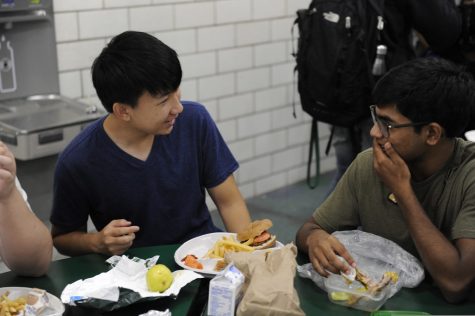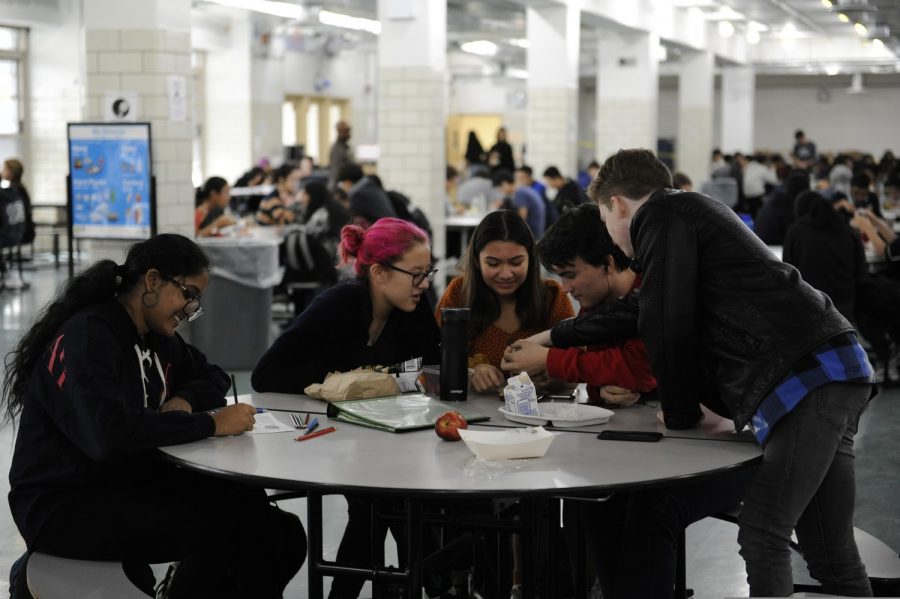Crafting a New Kind of Public School Food
Lunchtime is one of the most important parts of a student’s day, where they not only have the opportunity to socialize with friends but also to recharge their energy with a healthy meal.
In 1946 the U.S federal government established the National School Lunch Program (NSLP) under the National School Lunch Act. According to the USDA website, the NSLP “provides nutritionally balanced, low-cost or free lunches to children each school day.” However looking the phrase “American public school lunch” up online returns images of pizzas, canned peas, burgers, fries and chicken nuggets —foods that most people would not consider to be particularly nutritionally balanced. The USDA’s mission statement has come under the spotlight in recent years as students and parents across the country criticize the nutritional standards and regulation of public school food.
The New York City public school system, which serves meals to over one million students every day, is no exception. Despite creating progressive legislation that ensured increased minimum wage and reformed Pre-K for all, the city has fallen short when it comes to providing students with healthy public school food. What are the challenges that the NYCDOE faces in terms of bettering public school lunches and what solutions are school officials bringing to the table? What changes can Bronx Science students and other New York City public school students look forward to in the coming years?
To understand how public school food affects the well-being of America’s youth, it is important to first understand the statistics. According to the community organization NYC Healthy School Food Alliance, unhealthy public school food is a prevalent issue in a child’s everyday life and is a contributing factor to increasing obesity rates across the country. While school food is not the sole cause of rising obesity rates, 1 in 5 kindergarten children in NYC are obese while nationwide (since 1980) obesity in children and teenagers have almost tripled. Many consider the health issues of today’s youth to be intrinsically linked to the school environment, where students often eat processed and unhealthy meals. The introduction of processed foods to children in school may serve as the gateway to making poor food choices in the future, leading to diet-related diseases in the long term.
Research has shown that a healthy diet in combination with adequate physical exercise can help improve a student’s grade performance, behavior, and concentration. Despite an abundance of research backing up this claim, it seems clear that America’s public school food program does not do enough to provide healthy meals. American public school food is an inadequate source of nutrition, and can be detrimental to a student’s productivity and energy levels throughout the school day. The shortfalls of public school lunches have even led some students to avoid eating them altogether.
Across the country, public school students often skip getting school lunch due to its unappetizing flavors, inadequate portion sizes, and unhealthy ingredients. These are just some of the factors that play a role in public schools throwing away 60% of fresh vegetables and 40% of fresh fruits, according to a Harvard Public Health Study.
In New York City, the NYCDOE Office of Food and Nutrition Services (OFNS) understands the importance of access to healthy meals. While past attempts to reform school lunch have “failed,” OFNS has piloted new initiatives to better school lunches such as making school lunches free for students of all incomes. Most notably, OFNS has established a three-year partnership with Brigaid (beginning from 2018), a private school food consultation company founded by ex-Noma chef Dan Giusti. When working at Noma (A world class Michellen Star restaurant in Denmark), Giusti dreamed of creating a meaningful impact on a greater number of people beyond customers sitting in a restaurant. This dream motivated Giusti to look towards America (the country where he was born), specifically America’s public school food. He heard others talk about the issues of school food as an “unsolvable problem” and hoped to bring his cooking expertise to overhaul the broken system one step at a time.
In 2016, Giusti launched Brigaid in New England and oversaw a successful school food pilot in the area. He later decided to expand into New York City and work with OFNS in creating the “one chef, one school” initiative alongside the “Return to Scratch Cooking” pilot project. Giusti began the pilot project for schools in the Bronx after discovering that the borough had a high concentration of underprivileged communities with diet-related diseases.
Rather than serving preheated processed and fried foods, Brigaid’s project aims to help each school prepare fresh, made-from-scratch lunches. The entire process, evaluated by the Columbia Tisch Food Center and outlined in the “Cooking Outside the Box” report is broken down into four crucial steps: Ingredients and Recipes for Scratch Cooking, A Kitchen for Scratch Cooking, Cooking from Scratch, and Feeding the Community. From retrofitting school kitchens to planning new menu items, hiring cooking crew and adapting to a community’s tastes, Brigaid works within a certain budget and time frame to adequately meet the needs of the school administration, district, and its families.
Students at participating schools in the Bronx have welcomed the changes to their school food, eagerly eating new meals that consist of dishes ranging from freshly roasted chicken to handmade pizza. School food menu items also range from classic lunchroom staples such as peanut butter and jelly sandwiches to assorted fruits. With each item, Brigaid swapped normal ingredients with healthier alternatives, without compromising taste or texture. For example, instead of peanut butter, Brigaid uses sunflower butter, and instead of canned fruits, uses fresh ones.
Brigaid and OFNS still have a long way to go in terms of expanding the scratch-cooking project. Financially, New York City’s $550 million annual budget for school food means that the average cost for each school breakfast and lunch meal comes down to approximately $3.50. These costs have to cover both operating fees (such as hiring chefs and buying equipment) and ingredient costs. Additionally, Brigaid needs to create new recipes that can adhere to strict federal nutritional guidelines set by the National School Lunch Program (such as cooking meals that have less than 1080 milligrams of salt for students in 9th to 12th grade). Lastly, serving diverse school communities also means that Brigaid is constantly adapting and altering school meals to not only fit the student body’s tastes, but also to reduce food waste. For Brigaid and OFNS, it is important to make every dollar count and prioritize various goals and procedures.
Despite these challenges, Brigaid continues to be part of a growing movement that seeks to transform the American public school food landscape for the better. In New York City, the change has already begun, with an ambitious plan to roll out the made-from-scratch school food project to all NYC public schools, which, while it still is in the early stages, holds a lot of promise.
Brigaid continues to be part of a growing movement that seeks to transform the American public school food landscape for the better.

Brigaid looks to reinvent and create healthy, made from scratch meals starting from classic American public school food staples such as burgers and fries.
Kin Yang is a Staff Reporter for the ‘Science Survey.’ He finds that journalistic writing is an important way to explore and learn about new subject...
Gazi Fuad is a Chief Photographer & Photo Editor for the school yearbook ‘The Observatory.’ Outside of school, he is part of a team of photographers....
Rasheed Hossain is a Groups Section Reporter for the Bronx Science yearbook, ‘The Observatory,’ and a Sports Editor for the school newspaper, ‘The...
Nabeeha Alam is a Chief Graphic Designer for ‘The Observatory’ yearbook. She enjoys taking and analyzing journalistic photographs, as they capture...











